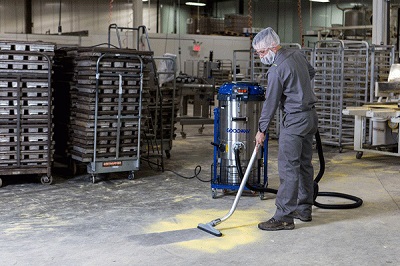As manufacturers across industries face increasing labor shortages and pressure to improve operational efficiency, Goodway Technologies is sharing best practices for identifying which industrial vacuum solutions can help maintain productivity and a clean environment.

From combustible dust removal to metal chip recovery and general debris management, industrial vacuums are designed to meet the specific demands of manufacturing environments. Selecting the incorrect industrial vacuum for the intended environment can be a costly and dangerous error.
“Not all vacuums are created equal, and selecting the right one depends on the materials being collected, the environment, and the frequency of use,” said Eric Potorski, industrial vacuum specialist at Goodway Technologies, a provider of HVAC and industrial maintenance solutions.
Step 1: Define the Application
Understanding the type, size, and nature of the material being collected is the first critical step in determining the industrial vacuum needed. Examples of the common substances industrial vacuum cleaners are designed to handle safely include scrap metal, metal chips, coolant, dust, debris, paint powder, food particles, and floodwater. From fine powders to heavy liquids, the application determines whether a dry, wet, or wet/dry vacuum is needed—and whether specialized features like explosion-proof certification are required.
Step 2: Choose the Right Filtration
A common question when purchasing an industrial vacuum cleaner for dry pickup is which filter is most appropriate. The environment and the application strongly influence whether to use a HEPA or a standard filter.
- HEPA Filters: According to the Occupational Safety and Health Administration, a HEPA, or high efficiency particulate air filter, is defined as a filter that is at least 99.97% efficient in removing particles of 0.3 micrometers in diameter. HEPA filters capture microscopic substances like dust mites and other airborne particles that can be hazardous or cause health issues. Depending on the industry, there are strict maintenance guidelines that must be adhered to properly clean a facility.
- Standard Filters: Standard filtration generally filters around 10 microns and performs well for the filtration of larger material pickup or areas where fine or hazardous materials aren’t present. Standard filters would not be sufficient for higher-risk areas, according to Goodway. While standard filters can be effective, they don’t offer the same amount of filtration as HEPA filters. This is why understanding the environment can help determine the best solution.
Step 3: Determine How Much Power Is Needed
Rather than focusing solely on horsepower, consider the following:
- Airflow Speed: If the application requires the pickup of dry materials, the airflow is a vital detail to consider. The airflow speed is measured by cubic feet per minute (CFM), and this force draws and collects particles inside the vacuum. The higher the CFM of the airflow, the more volume received when picking up fine powders, such as flour or dust particles.
- Static Lift: The static lift is directly related to the power of the airflow and its ability to lift the material. Vacuums designed for lifting liquids or heavy metals will have high lift specifications. When suctioning fluids with high density, such as water, a higher static lift and a lower CFM are required to allow the vacuum to lift these substances.
Step 4: Consider Capacity and Disposal
Industrial vacuums don’t utilize small collection or dust bags that need to be frequently replaced. They are designed with a larger capacity to simplify the process and typically vary in size to meet different needs.
In addition to the size, the canisters where the debris or liquid is collected may also come with different features. For wet vacuums, consider an option with a tilting tank or pump to make it easier to remove accumulated liquid.
Step 5: Account for Safety and Special Features
Industrial vacuum cleaners have specific needs depending on what is being collected. A good practice for choosing an industrial vacuum cleaner is assessing what materials and voltage will be used to maintain safety protocols. When cleaning areas with hazardous dust or liquid, vacuums should be explicitly certified for those material pickups. Using uncertified products could end in catastrophe.
Ultimately, finding an industrial vacuum cleaner that matches the environment and application will result in more effective and safe cleaning.
